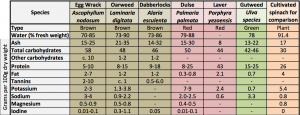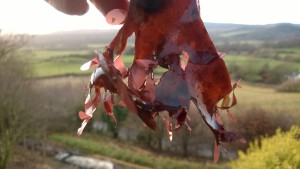Dulse – Identification, Edibility, Distribution
Palmaria palmata AKA Dillisk
Related pages:
- Identification – 4/5 – A medium sized (10cm-40cm) flat red seaweed that usually looks a rusty purple/brown colour. Irregularly branched and divided lobes.
- Edibility – 4 /5 – Though not strong in flavour, dulse is one of the stars of the seaweed world – a clinically proven antioxidant and source of protein, potassium and iodine, making it an excellent treatment for hypothyroid problems.
- Habitat – You can find dulse on most rocky shores at any reasonably low tide, but you do need to ensure the tide is fully out to make gathering easy. Grows either from a small discoid holdfast on the rock or epiphytically on other seaweeds, notably the large stalks of forest kelp (laminaria hyperborea). Hangs in clumps when exposed.
- Distribution – 5/5 – Very common in suitable habitats within its tidal range. Best picked, as with most seaweeds, where it is washed by strong currents.
- Season – All year round, but at its best slightly later than most seaweeds in June and July (at least where I am!).
- How to harvest – There is very little danger of poisoning yourself through misidentification provided you harvest fresh from the rocks from clean water, as there are no toxic inshore seaweed species. Harvest by cutting up 2/3rds with a sharp pair of scissors, leaving the holdfast to grow back.
- How to eat – Dulse has a rich, salty, meaty flavour – it has been marketed as a vegetarian substitute for bacon! It is delicious raw, if a little chewy, and makes an excellent, deeply nourishing on-the-hoof snack. It can also be cooked as a vegetable (excellent in stir-fries) or dried and flaked to use in stocks, soups, breads, sauces – whatever you like really. There are very few savoury dishes it doesn’t improve, especially when dried and powdered. Deep fried into dulse crisps, it makes an excellent beer snack. It is extremely high in umami, so great for dashi broths and the basis of miso soups.
Related pages:





2 Comments
Mark have you any tips for powdering it when dried? I baked mine in the oven but my blender can’t get through it.
Yes, it is tough isn’t it!? I usually resort to finely chopping with a very sharp, heavy chef’s knife. I think a thermomix would do the job, if it was freshly toasted.